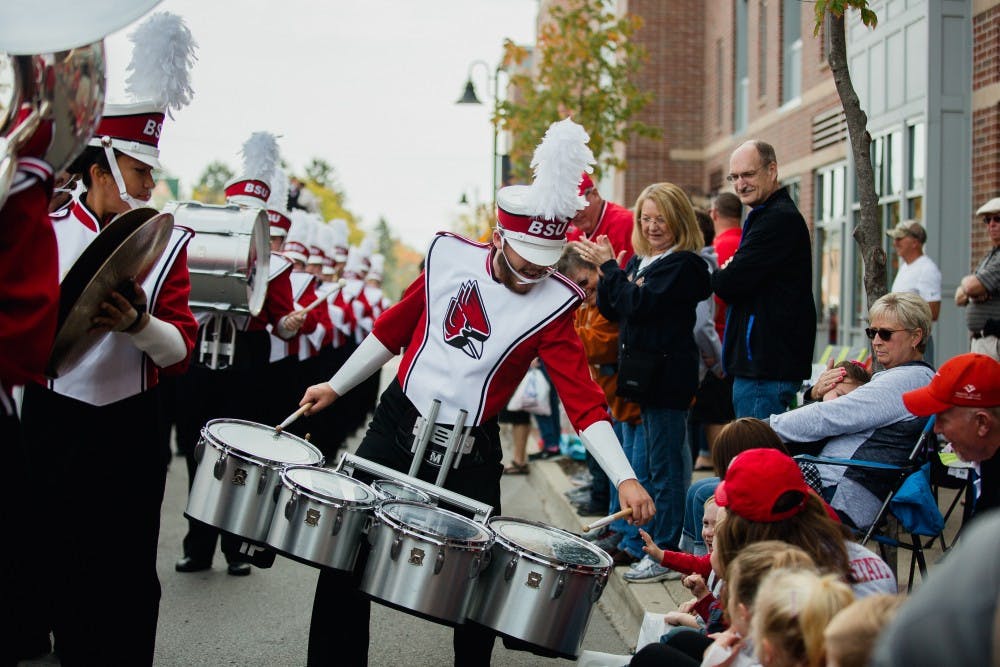Editor's note: In honor of the university's centennial year, The Daily News is counting down 100 days to the university's celebration Sept. 6 with 100 of Ball State's most famous traditions and figures. Check back each day to read about Cardinal history.
The Pride of Mid-America’s history is long and dynamic, with the marching band's roots tracing back to Ball State’s fourth director of bands.
In 1945, President John R. Emens selected Robert Hargreaves to serve as the director of bands, a position he held for one year. Emens believed Hargreaves could “guide the destiny of music at Ball State Teachers College,” according to Ball State’s School of Music.
Hargreaves, who Ball State's music building is named after, was the director of the School of Music from 1945 until he retired in 1981.
In 1950, Hargreaves appointed Herbert Fred, a nationally recognized composer and arranger to serve as the director of bands.
According to Ball State’s School of Music, Fred's marching bands were one of the first in the country to perform drill patterns, a concept originally established for an all-male group. It quickly evolved to include women.
Over the next seven years, the band program continued to progress, leading up to the arrival of Iowa native Earl Dunn.
Dunn, who Hargreaves selected to become the sixth director of bands in 1957, held the position for 12 years.

Earl Dunn, former director of bands, practices with his marching band for the 1965 inaugural parade. Photo courtesy of Ball State's Digital Media Repository.
Under Dunn's leadership, Ball State's marching band was named "The Pride of Mid-America" and by the mid-1960's the group had nearly tripled, going from 66 to 190 members, according to Ball State’s School of Music.
During that time, the marching band "established a reputation for playing 'Big Band' styled arrangements," which included the addition of a flag corps that performed alongside the band in halftime shows.
RELATED: Former Director of Bands remembered for leadership, friendship
Dunn directed multiple performances that made school history, including the 1967 NFL Western Conference Championship Game.
"The Pride" became the first university band in the state to use "contemporary curvilinear forms to emphasize and portray the band's music on the field" in 1984 under the leadership of Joseph Scagnoli, according to Ball State’s School of Music. Scagnoli, the ninth director of bands, served as “The Pride” director for 15 years.
Since 1998, "The Pride" has been led by five different directors, participated in dozens of substantial events and continues to grow in membership.
RELATED: BSU band rocks Lucas Oil with tribute to late King of Pop
Today, the marching band is made up of more than 200 students performers, composed of the woodwind and brass sections, drumline and color guard.
"A college marching band has a tremendous role to play in the life of the campus, especially at football games. It is the one organization on campus that can bind all generations of our BSU community, students, staff, faculty, alumni and community members, together in spirit," Shawn Vondran, 2010-14 assistant director of bands, said in a 2011 Daily News interview.
"Whether it's singing the National Anthem, clapping along with the Fight Song, or putting an arm around a friend for the playing of the Alma Mater, the marching band gives everyone the opportunity to participate in the life of the university and have a greater connection to it."
"The Pride" continues to unite Cardinals together through its high-energy performances, under the direction of Caroline Hand, who joined Ball State in 2015.
RELATED: New associate director of bands takes over marching, symphony bands
In addition to the Pride of Mid-America Marching Band, the Ball State band program includes the Wind Ensemble, Symphony Band, Concert Band, Campus Band, Ceremonial Band, Basketball Band and other athletic pep bands. Membership is open to all students, regardless of musical ability level or major field of study.
Read more centennial content here.
Contact Allie Kirkman with comments at aekirkman@bsu.edu or on Twitter@alliekirkman15.





